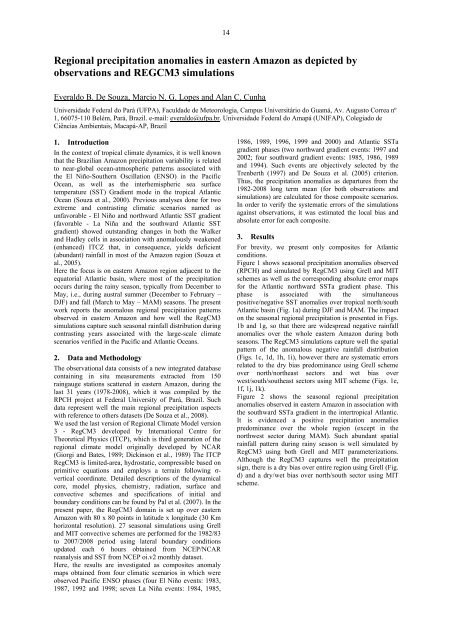Low (web) Quality - BALTEX
Low (web) Quality - BALTEX
Low (web) Quality - BALTEX
Create successful ePaper yourself
Turn your PDF publications into a flip-book with our unique Google optimized e-Paper software.
14<br />
Regional precipitation anomalies in eastern Amazon as depicted by<br />
observations and REGCM3 simulations<br />
Everaldo B. De Souza, Marcio N. G. Lopes and Alan C. Cunha<br />
Universidade Federal do Pará (UFPA), Faculdade de Meteorologia, Campus Universitário do Guamá, Av. Augusto Correa nº<br />
1, 66075-110 Belém, Pará, Brazil. e-mail: everaldo@ufpa.br. Universidade Federal do Amapá (UNIFAP), Colegiado de<br />
Ciências Ambientais, Macapá-AP, Brazil<br />
1. Introduction<br />
In the context of tropical climate dynamics, it is well known<br />
that the Brazilian Amazon precipitation variability is related<br />
to near-global ocean-atmospheric patterns associated with<br />
the El Niño-Southern Oscillation (ENSO) in the Pacific<br />
Ocean, as well as the interhemispheric sea surface<br />
temperature (SST) Gradient mode in the tropical Atlantic<br />
Ocean (Souza et al., 2000). Previous analyses done for two<br />
extreme and contrasting climatic scenarios named as<br />
unfavorable - El Niño and northward Atlantic SST gradient<br />
(favorable - La Niña and the southward Atlantic SST<br />
gradient) showed outstanding changes in both the Walker<br />
and Hadley cells in association with anomalously weakened<br />
(enhanced) ITCZ that, in consequence, yields deficient<br />
(abundant) rainfall in most of the Amazon region (Souza et<br />
al., 2005).<br />
Here the focus is on eastern Amazon region adjacent to the<br />
equatorial Atlantic basin, where most of the precipitation<br />
occurs during the rainy season, typically from December to<br />
May, i.e., during austral summer (December to February –<br />
DJF) and fall (March to May – MAM) seasons. The present<br />
work reports the anomalous regional precipitation patterns<br />
observed in eastern Amazon and how well the RegCM3<br />
simulations capture such seasonal rainfall distribution during<br />
contrasting years associated with the large-scale climate<br />
scenarios verified in the Pacific and Atlantic Oceans.<br />
2. Data and Methodology<br />
The observational data consists of a new integrated database<br />
containing in situ measurements extracted from 150<br />
raingauge stations scattered in eastern Amazon, during the<br />
last 31 years (1978-2008), which it was compiled by the<br />
RPCH project at Federal University of Pará, Brazil. Such<br />
data represent well the main regional precipitation aspects<br />
with reference to others datasets (De Souza et al., 2008).<br />
We used the last version of Regional Climate Model version<br />
3 - RegCM3 developed by International Centre for<br />
Theoretical Physics (ITCP), which is third generation of the<br />
regional climate model originally developed by NCAR<br />
(Giorgi and Bates, 1989; Dickinson et al., 1989) The ITCP<br />
RegCM3 is limited-area, hydrostatic, compressible based on<br />
primitive equations and employs a terrain following σ-<br />
vertical coordinate. Detailed descriptions of the dynamical<br />
core, model physics, chemistry, radiation, surface and<br />
convective schemes and specifications of initial and<br />
boundary conditions can be found by Pal et al. (2007). In the<br />
present paper, the RegCM3 domain is set up over eastern<br />
Amazon with 80 x 80 points in latitude x longitude (30 Km<br />
horizontal resolution). 27 seasonal simulations using Grell<br />
and MIT convective schemes are performed for the 1982/83<br />
to 2007/2008 period using lateral boundary conditions<br />
updated each 6 hours obtained from NCEP/NCAR<br />
reanalysis and SST from NCEP oi.v2 monthly dataset.<br />
Here, the results are investigated as composites anomaly<br />
maps obtained from four climatic scenarios in which were<br />
observed Pacific ENSO phases (four El Niño events: 1983,<br />
1987, 1992 and 1998; seven La Niña events: 1984, 1985,<br />
1986, 1989, 1996, 1999 and 2000) and Atlantic SSTa<br />
gradient phases (two northward gradient events: 1997 and<br />
2002; four southward gradient events: 1985, 1986, 1989<br />
and 1994). Such events are objectively selected by the<br />
Trenberth (1997) and De Souza et al. (2005) criterion.<br />
Thus, the precipitation anomalies as departures from the<br />
1982-2008 long term mean (for both observations and<br />
simulations) are calculated for those composite scenarios.<br />
In order to verify the systematic errors of the simulations<br />
against observations, it was estimated the local bias and<br />
absolute error for each composite.<br />
3. Results<br />
For brevity, we present only composites for Atlantic<br />
conditions.<br />
Figure 1 shows seasonal precipitation anomalies observed<br />
(RPCH) and simulated by RegCM3 using Grell and MIT<br />
schemes as well as the corresponding absolute error maps<br />
for the Atlantic northward SSTa gradient phase. This<br />
phase is associated with the simultaneous<br />
positive/negative SST anomalies over tropical north/south<br />
Atlantic basin (Fig. 1a) during DJF and MAM. The impact<br />
on the seasonal regional precipitation is presented in Figs.<br />
1b and 1g, so that there are widespread negative rainfall<br />
anomalies over the whole eastern Amazon during both<br />
seasons. The RegCM3 simulations capture well the spatial<br />
pattern of the anomalous negative rainfall distribution<br />
(Figs. 1c, 1d, 1h, 1i), however there are systematic errors<br />
related to the dry bias predominance using Grell scheme<br />
over north/northeast sectors and wet bias over<br />
west/south/southeast sectors using MIT scheme (Figs. 1e,<br />
1f, 1j, 1k).<br />
Figure 2 shows the seasonal regional precipitation<br />
anomalies observed in eastern Amazon in association with<br />
the southward SSTa gradient in the intertropical Atlantic.<br />
It is evidenced a positive precipitation anomalies<br />
predominance over the whole region (except in the<br />
northwest sector during MAM). Such abundant spatial<br />
rainfall pattern during rainy season is well simulated by<br />
RegCM3 using both Grell and MIT parameterizations.<br />
Although the RegCM3 captures well the precipitation<br />
sign, there is a dry bias over entire region using Grell (Fig.<br />
d) and a dry/wet bias over north/south sector using MIT<br />
scheme.













